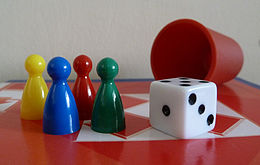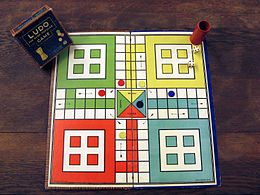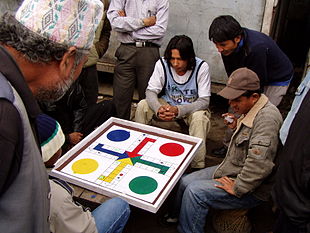




Four Ludo pieces, a die and a dice cup on a Ludo board
|
|
| Years active | Since c. 1896 |
|---|---|
| Genre(s) | Board game Race game |
| Players | 2-4 |
| Age range | 4 and up |
| Playing time | < 120 min |
| Random chance | Medium (dice rolling) |
| Skill(s) required | Strategy, tactics, counting, probability |
Ludo , (from Latin ludo, "I play") is a board game for two to four players, in which the players race their four tokens from start to finish according to die rolls. Like other cross and circle games, Ludo is derived from the Indian game Pachisi, but simpler. The game and its variants are popular in many countries and under various names.
Pachisi originated in India by the 6th century. The earliest evidence of this game in India is the depiction of boards on the caves of Ajanta. This game was played by the Mughal emperors of India; a notable example is Akbar.
In England, Pachisi was modified, using six-sided dice, and patented as Ludo, in 1896, patent number 14636
In North America, the game is sold under the brand name Parcheesi. Variations of the game are sold under the brand names Sorry!, Aggravation, and Trouble.
In Germany, this game is called "Mensch ärgere dich nicht" which means "Man, don't get irritated", and has equivalent names in Bulgarian, Croatian, Czech, Dutch, Polish, Russian, Serbian, Slovak, and Slovene. In Iran, the game is called "منچ" [Mench] which is probably an adaptation of the German name. In Polish it is more commonly referred to as Chińczyk ("The Chine(s)e").
In Estonia, it is called "Reis ümber maailma" (Trip around the world).
In Greece, the game is called "Γκρινιάρης" [Griniaris] ("Grumbler") referring to typical player behaviour.
In Malaysia and Singapore, it is called "飞机棋".
In Macedonia, the game is called "Не лути се човеку", meaning "Don't get angry, man".
In Sweden it is known as "Fia", a name derived from the Latin word fiat which means "so be it!" Common variations on the name are "Fia-spel" (Fia the game) and "Fia med knuff" (Fia with push). In Denmark and Norway though, the game is known as Ludo.
In Vietnam, it is called "Cờ cá ngựa".
 Original Ludo board with marked direction of play
Original Ludo board with marked direction of playSpecial areas of the Ludo board are typically coloured bright yellow, green, red, and blue. Each player is assigned a colour and has four tokens of matching colour (originally bone discs but nowadays tokens made of cardboard or plastic). The board is normally square with a cross-shaped game track, with each arm of the cross consisting of three columns of squares - usually six squares per column. The middle columns usually have five squares coloured, and these represent a player's home column. A sixth coloured square not on the home column is a player's starting square. At the centre of the board is a large finishing square often composed of triangles in the four colours atop the players' home columns - thus forming "arrows" pointing to the finish.
Two, three, or four may play. At the beginning of the game, each player's tokens are out of play and staged in one of the large corner areas of the board in the player's colour (called the player's yard ). When able to, the players will enter their tokens one per time on their respective starting squares, and proceed to race them clockwise around the board along the game track (the path of squares not part of any player's home column). When reaching the square below his home column, a player continues by racing tokens up the column to the finishing square. The rolls of a cube die control the swiftness of the tokens, and entry to the finishing square requires a precise roll from the player. The first to bring all their tokens to the finish wins the game. The others often continue play to determine second-, third-, and fourth-place finishers.
 Diagram of a typical Ludo board. The diamond shapes contain each player's staging squares.
Diagram of a typical Ludo board. The diamond shapes contain each player's staging squares.Each player rolls the die, the highest roller begins the game. The players alternate turns in a clockwise direction.
To enter a token into play from its staging area to its starting square, a player must roll a 6. If the player has no tokens yet in play and does not roll a 6, the turn passes to the next player. Once a player has one or more tokens in play, he selects a token and moves it forward along the track the number of squares indicated by the die roll. Players must always move a token according to the die value rolled, and if no move is possible, pass their turn to the next player.
When a player rolls a 6 he may choose to advance a token already in play, or alternatively, he may enter another staged token to its starting square. The rolling of a 6 earns the player an additional ("bonus") roll in that turn. If the additional roll results in a 6 again, the player earns an additional bonus roll. If the third roll is also a 6, the player may not move a token and the turn immediately passes to the next player.
A player may not end his move on a square he already occupies. If the advance of a token ends on a square occupied by an opponent's token, the opponent token is returned to its owner's yard. The returned token may only be reentered into play when the owner again rolls a 6. Unlike Pachisi, there are no "safe" squares on the game track which protect a player's tokens from being returned. A player's home column squares are always safe, however, since no opponent may enter them.
 Pachisi variant being played on a Ludo board in Nepal
Pachisi variant being played on a Ludo board in NepalIn some parts of Africa the following rules are reportedly played: